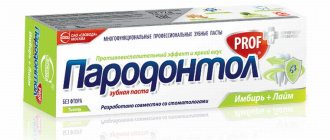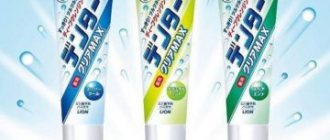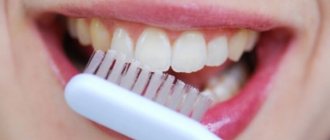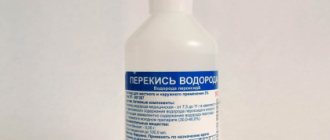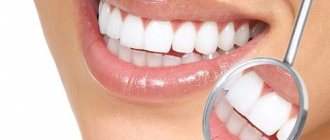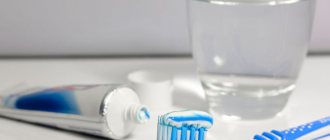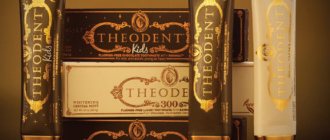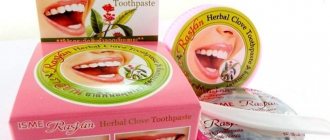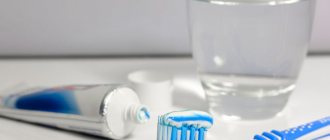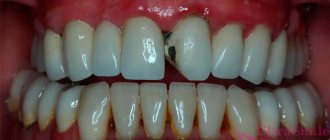No dentist will give a definite answer to the question of which toothpaste you should choose for regular teeth cleaning.
The huge range of toothpastes on the modern market leaves the right of choice to the patient, since the effectiveness of the paste can only be determined after personal experience of using it.
The doctor can only explain which series of products should be used to brush teeth in a particular situation, based on the patient’s oral problems.
Properties of toothpastes
A good toothpaste should have certain properties, namely:
- have a pleasant taste and smell;
- produce a high refreshing effect;
- prevent the formation of plaque on teeth;
- be homogeneous;
- do not dry out or delaminate during storage;
- have an anti-caries effect;
- do not cause allergic reactions, be harmless to the body;
- correspond to the effect stated on the label after use;
- For complete teeth cleaning, a strip of paste 0.5-1 cm long should be enough.
To choose the right toothpaste, you need to carefully study its purpose and composition, since different products are used for different problems of the oral cavity.
Top 3. ROCS Pro Brackets & Ortho
Rating (2021): 4.64
290 reviews from resources were taken into account: Yandex.Market, Ozon, Wildberries, Otzovik, IRecommend
The best solution for wearing braces ROCS Pro Brackets & Ortho is designed specifically for those who wear braces or dentures. The paste has improved cleansing properties and can rightfully be considered the best in its category.
- Characteristics
Average price: 380 rub. (135 g)
- Active ingredients: bromelain, xylitol, calcium
- Properties: high-quality cleansing, protection against caries
ROCS Pro Brackets & Ortho is designed specifically to meet the needs of those who wear orthopedic or orthodontic structures in the mouth - braces, removable bite correction devices or dentures. The composition of the product helps to more effectively clean the mouth and dissolve plaque, even in places where it is impossible to reach with a toothbrush. The formula with enzymes and minerals helps protect teeth from caries and gums from inflammation. Reviews from those who have tried this product are only positive and confirm that its cleansing effect is truly excellent. The only drawback is the high price, but this paste can be forgiven given its high quality.
Advantages and disadvantages
- Specialized product for those who wear braces or dentures
- Improved formula for complete teeth cleaning
- Helps protect teeth from caries and gums from inflammation
- High price
See also:
- 10 Best Remedies for Bad Breath
What types of toothpastes are there?
Based on their effect on the oral cavity, pastes are divided into therapeutic, therapeutic and prophylactic and prophylactic. Belonging to one or another group is indicated on the front side of the package, so determining the purpose of the paste at the time of purchase is not difficult.
Depending on the age orientation, pastes are divided into children's and adults. Children's products for small children have a special composition, since there are often cases of them being swallowed by children during cleaning, and the components of adult pastes are prohibited here. Manufacturers add the same substances to toothpastes for older children as to adult products, but in lower concentrations.
“You should brush your teeth after eating”
Olga Popovkina, dentist, expert on certification of oral hygiene products:
— When choosing a toothpaste, you must first of all focus on the recommendations of your dentist, who will not only advise you to purchase this or that toothpaste, but will also explain exactly what substances it should contain in order to provide optimal care for your teeth and oral cavity.
Full information about the content, as well as other information: name of the product and manufacturer, trademark, weight or volume, composition, expiration date, certification information (for example, PCT AB07 mark), for products containing fluorides, fluoride content according to GOST R 51391-99 - must be indicated on the packaging, and in Russian.
You need to brush your teeth at least twice a day, after meals. Many people brush their teeth in the morning before breakfast, but this is wrong. You can rinse your teeth before breakfast, but be sure to brush them after eating, otherwise food debris will create a breeding ground for bacteria for the whole day.
Composition of toothpastes
There are standard components that are included in any paste, regardless of its purpose:
- Abrasives are chalk additives, silicon and calcium compounds. Abrasive components are responsible for the quality of cleansing enamel from plaque.
- Water, glycerin - maintain moisture and consistency of the paste.
- Xanthan gum is a stabilizer and thickener, also responsible for the consistency of the product.
- Foaming substances - depending on their amount, the paste foams more or less while brushing your teeth.
- Sorbitol or xylitol – give the paste a sweet taste. Sorbitol also serves as an emulsifier, and xylitol inhibits the development of cariogenic bacteria.
- Preservatives (sodium benzoate, parabens) – prevent the development of bacteria in an open tube, extend the shelf life of the paste. Should be used in limited quantities in products for children.
- Flavorings – peppermint oil is most often used.
Undesirable components that should be excluded from the composition, or their quantity should be reduced to a minimum, include:
- Polyethylene glycol (PEG) is harmful to the kidneys.
- Sodium lauryl sulfate - in large quantities has a negative effect on the mucous membranes of the mouth and stomach.
- Triclosan, chlorhexidine - have an antibacterial effect and are allowed only for medicinal pastes. With prolonged daily use of products containing these substances, the vital activity of the normal microflora of the oral cavity is disrupted.
All pastes are the same in their own way
Last year, Russian consumers spent $777 million on dental cleanliness (data from the Staraya Krepost expomedia group). Approximately half of sales come from foreign manufacturers, led by Colgate-Palmolive and Procter & Gamble (according to the head of the technical committee for oral hygiene products, Eleonora Sakharova, “at the moment, the Russian market represents almost the entire range of global ones in terms of the composition and quality of raw materials “Domestic pastes are in no way inferior to foreign ones,” emphasizes Eleonora Sakharova. “Both use imported raw materials, and domestic producers often purchase them from the same places as their foreign competitors.”
As for the quality of the final product, there are internationally accredited research institutes in Russia and abroad that test toothpastes for safety and compliance with quality standards. Pastes sold on the Russian market must meet the requirements of GOST 7983-99 and GOST R 51 391-99. In laboratory studies, the composition of the paste, its safety, consistency of consistency with GOST requirements, the convenience and safety of packaging, as well as the cleansing and therapeutic properties of the paste are checked. “According to these standards, all products, both domestic and foreign, are checked without exception. Toothpaste that has not passed the mandatory certification procedure cannot be sold on the Russian market,” says Olga Popovkina, head of the product certification body of the Federal State Institution TsNIISiChLH Rosmedtekhnologii, an expert in certification of oral hygiene products.
Preventative toothpastes
Preventive toothpastes are also called hygienic; their purpose is daily oral care without therapeutic effects. They are used to cleanse and refresh the oral cavity, if there are no complaints about the condition of the teeth and gums.
The main components of these pastes are: chemically precipitated chalk, glycerin, water, flavorings, preservatives and thickeners. Fluoride and calcium are sometimes added to prophylactic products to prevent the development of caries.
Therapeutic and prophylactic agents This is the most extensive group of toothpastes; it is divided into several subgroups.
Top 6. SPLAT Professional Biocalcium
Rating (2021): 4.59
1646 reviews from resources were taken into account: Yandex.Market, Ozon, Wildberries, Otzovik, IRecommend
The most popular SPLAT Professional Biocalcium is the most popular toothpaste among those presented in the rating, because we were able to find the most positive reviews about it from dentists and ordinary people.
- Characteristics
Average price: 150 rub. (100 g)
- Active ingredients: bioactive calcium, papain
- Properties: comprehensive care, remineralization
SPLAT Professional Biocalcium is an excellent solution for fully strengthening enamel and reducing tooth sensitivity. Bioactive calcium, obtained from eggshells, as well as hydroxyapatite, which are present in the composition, are the most valuable building material for tooth enamel. The presence of papain in the paste guarantees high-quality teeth cleaning, and sodium bicarbonate cares for the gums and normalizes the pH level. The product has proven its effectiveness in combating tooth sensitivity, as well as restoring enamel in the initial stages of caries. It also has a slight whitening effect. We found a lot of reviews about this paste, and it receives only high ratings.
Advantages and disadvantages
- High-quality composition for strengthening enamel
- Helps with the initial stages of caries
- Complete cleansing and care for gums
- Lots of positive reviews
- Weak whitening effect
Fluoride-containing pastes
Such pastes are enriched with fluoride in the form of sodium fluoride, aminofluoride or monofluorophosphate in various concentrations. The designation of fluoride concentration on the packaging can be seen as the abbreviation “ppm” (parts per million). For adults, this value should not be higher than 1500 ppm. Fluoride-containing toothpaste should not be swallowed, so it should not be used on children who cannot spit and rinse their mouths.
Fluoride is effective in preventing the development of caries, but it should only be used in areas where low fluoride levels in the water have been confirmed. Residents of areas with sufficient fluoride levels should not use fluoride toothpastes. If you neglect this rule, due to an excess of the element in the body, dental fluorosis will develop - a violation of the pigmentation and structure of tooth enamel.
Remineralizing pastes
The products are designed to strengthen the enamel by saturating it with calcium and phosphorus compounds. Typically, pastes contain calcium citrate and calcium glycerophosphate. To get the proper effect, you need to brush your teeth for at least three minutes.
In addition to toothpastes, remineralizing gels are used at home: they are applied to the teeth and left for the time specified in the instructions for the product.
The use of remineralizing agents is especially indicated for children from 6 years of age, during adolescence, when permanent teeth appear, intensive skeletal growth occurs and the need for calcium increases. Pastes are also recommended for pregnant women, as their tooth enamel often suffers from a lack of calcium.
How do abrasive toothpastes affect teeth?
The effect of abrasive pastes is similar to the effect of a scrub - small particles (abrasives) clean and polish the tooth. This will not replace professional whitening, but it will lighten the enamel by several tones. Moreover, it will do it quickly enough (the effect is visible almost immediately). It is quite safe to use such pastes, and their prices are quite affordable.
Any toothpaste contains abrasives - hard microparticles. In abrasive pastes, these particles are larger and therefore have a better cleaning effect.
Silicon compounds, titanium, aluminum oxide, polyethylene, calcium carbonate (chalk), clay, soda, and charcoal are used as abrasives. Some pastes contain multiple abrasives.
Pastes with whitening effect
Many manufacturers of whitening toothpastes are disingenuous when they call them whitening; it would be more correct to call them “brightening” or “with an increased cleansing effect.” Lightening of enamel in pastes occurs by removing plaque and returning the natural color to the teeth. True enamel whitening can only be done in the dentist's office.
Removal of plaque using this group of products occurs due to increased abrasiveness; a tube of paste with a truly cleansing effect should contain information about the abrasiveness index. It is designated by the letters RDA; the higher the digital value of the index, the larger the grinding particles. RDA index values:
- 30-50 – non-abrasive paste, suitable for cleaning sensitive teeth;
- 50-80 – low abrasive, can be used by children over 14 years of age;
- 80-100 – moderately abrasive, used by adults daily;
- 100-200 – high abrasiveness of the paste, teeth are brushed 1-2 times a week, sometimes less often; It is advisable to consult a dentist before use.
The recommended abrasiveness for daily use is RDA 70-80, but you need to focus on the condition of your teeth and gums.
There are pastes in which the enamel is cleansed not through abrasive particles, but through the action of the enzymes papain and bromelain. Enzymes enter into a chemical reaction with plaque, gradually dissolving it.
If the packaging of a whitening toothpaste does not contain information about the RDA index or does not contain enzymes, it is unlikely that this product will be able to lighten tooth enamel.
Top 8. Biomed White Complex
Rating (2021): 4.55
544 reviews from resources were taken into account: Yandex.Market, Ozon, Wildberries, Otzovik, IRecommend
- Characteristics
Average price: 95 rub. (100 g)
- Active Ingredients: Activated Charcoal, Bamboo Charcoal, Bromelain
- Properties: plaque cleansing, whitening, enamel restoration
Biomed White Complex – dark paste for snow-white teeth. It contains three types of carbon - activated, charcoal and bamboo, which help effectively remove plaque and absorb toxins. The composition also contains calcium and L-arginine to strengthen enamel, zinc citrate, which has antibacterial and anti-inflammatory properties, plantain and birch leaf extracts to protect gums. It is extremely important that the composition does not contain fluoride, parabens, SLS or fragrances. This makes the paste quite safe and approved for use even in children over 6 years of age. The whitening effect is insignificant, but the manufacturer himself says that in 4 weeks you can lighten your teeth by a maximum of 1 tone.
Advantages and disadvantages
- Affordable price
- Natural composition without harmful components
- Three types of charcoal to cleanse and protect against toxins
- Suitable for children from six years old
- Slight brightening effect
Products for sensitive teeth
Pastes for sensitive teeth contain strontium chloride, potassium nitrate and sodium citrate - substances that block the sensitivity of nerve endings. A common component is hydroxyapatite; it is capable of creating a protective film on enamel. The pastes also contain extracts and oils of medicinal herbs, which have a beneficial effect on the condition of the gums.
Decreased tooth sensitivity develops a few days after starting to use the medicinal paste. But such products cannot be used for too long due to the fact that they do not have sufficient abrasiveness and do not remove plaque well. In addition, a constant decrease in tooth sensitivity leads to masking the symptoms of other diseases, such as caries.
At first, soft toothbrushes are used with toothpaste for sensitive teeth, but as soon as the painful sensations disappear, you need to return to a regular brush with medium bristles (medium hardness). If this is not done, plaque will begin to accumulate on the enamel.
After a treatment course with toothpaste for sensitive teeth, they switch to using remineralizing pastes.
Top 7. Forest balm against bleeding gums
Rating (2021): 4.57
1556 reviews from resources were taken into account: Yandex.Market, Ozon, Wildberries, Otzovik, IRecommend
- Characteristics
Average price: 60 rub. (75 g)
- Active ingredients: extracts of oak bark, fir, juniper, decoction of 5 herbs
- Properties: strengthens gums, reduces bleeding
Forest balm against bleeding gums with oak bark and fir is a popular toothpaste with a low cost and a promising composition. It guarantees a 94% reduction in bleeding, relieves inflammation and helps strengthen the gums. Its regular use is aimed at increasing one’s own immunity in the oral cavity and getting rid of unpleasant sensations. Extracts of fir, resin, juniper and a decoction of five medicinal herbs give the paste a pronounced pine taste and aroma that almost everyone likes, although there are exceptions. In addition to herbal components, the composition also contains chemical ones, and not the safest ones. Whether this should be considered a disadvantage - let everyone decide for themselves.
Advantages and disadvantages
- Affordable price
- Plant extracts and herbal decoction included
- Pronounced positive effect on the condition of the gums
- Contains harmful substances
- Not everyone likes the pine taste and aroma
